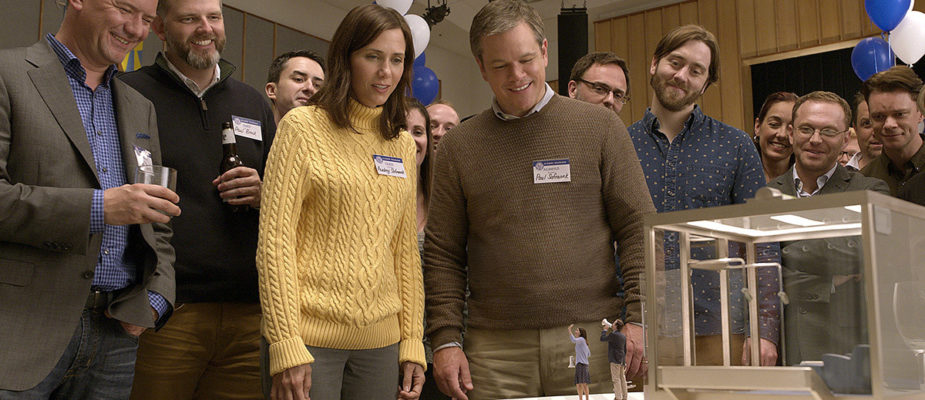I have been told by a friend, after sharing my own keen admiration for Alexander Payne’s Downsizing, that everyone he knows hated the film. No surprise, as the under-25 critic seated next to me pivoted from howls of hysterical laughter at the site of seeing people reduced to many times their original size to dead silence as Downsizing found its intellectual center—as work of economic disparity and charitable work. Downsizing is a bit of a Trojan horse, articulating its meaningful interventions on the racial and class dynamics present in our perfect urban societies (and other utopias everywhere) within an eco-panic narrative that sees the end of the species on the comparative near horizon. Payne’s film, and this I suspect is why it has been received so coldly by a segment of the American critical public, really is not a safe space in an era when class (and Christian religion) has been expunged from consensus liberal-left politics, having been replaced in part by the environmental concerns that are ostensibly the film’s subject.
Downsizing opens some years ago in a Norwegian lab, with a scientist first perfecting the extreme miniaturization of a lab rat. Jumping ahead in time, the potentially earth-saving discovery is announced on stage by the now microscopic scientist, addressing a group of his enthusiastic colleagues on the equally undersized lectern that gave my viewing neighbor such fits of laughter. With more years and decades passing, the technology becomes economically accessible to the middle-class who are sold on the economic benefits of a literally smaller lifestyle, one that, as a product of physical scale, allows an upper-class, retirement-like lifestyle to the lower middle and working classes: one’s money goes a lot further in this brave new, tiny—ultra suburban—world (of Tony Roma’s and Chico’s in picturesque new-urbanist spaces). And yes, there is the acknowledgement that this will help save the planet—a selling point for some, and an afterthought for many more.
Matt Damon stars as Paul Safranek, an Omaha-based occupational therapist, Paul Safranek, who struggles to make ends meet, along with his wife (played by Kristin Wiig). When the couple come into contact with Paul’s now shrunk, happy and wealthy old friend (Jason Sudeikis) at a high school reunion, Damon and Wiig decide to take the leap—a decision that, on paper, will make them financially comfortable for the rest of their lives. Celebrating their bittersweet decision with friends and family, Paul is accosted by a drunken bar patron who asks whether the downsized should have the same rights as everyone else (given that they will pay far less in sales tax, etc. as a result of their new lifestyle); he’s the angry white middle American male whose economic self-interested turned the last election, and whose estrangement from the Democratic Party has led to the present realignment of the American political landscape. Downsizing, make no mistake, is a film about the fate of the contemporary Democratic Party, framed once again, by the unassailable assumptions about environment that provides the present party with its common ground.
Without wishing to spoil to much of the film’s plot, Paul finds himself far less well off than expected after being shrunk and relocated to the planned community of his choice outside of Sante Fe, New Mexico: Paul quickly is forced to move from his micro McMansion into a sad little flat, and his very early retirement becomes a job in a call center—a common profession in the director’s home state. Living above Paul is Christoph Waltz’s Dusan Mirkovic, a European bon vivant who surrounds himself with leggy downsized ladies and Little Ronni, a sex-crazed young celebrity in this parallel universe. His complaints about the noise above become a psychotropic night of partying—a night and morning that is finally punctuated by the arrival of a cleaning service of familiar cleaning types.
With their arrival, Payne further gives lie to the promises of (a very suburban form of) utopia for which Paul and his wife have signed away their life savings. Undocumented immigrants and refugees in this small world, Dusan’s housekeepers live otherwise outside of the film’s ideal, work-free economy (Downsizing is also a film of explicit anti-communism), traveling by bus through a hole in the wall of the planned community to their meager high rise estate. It is in this environment, ultimately, that Paul will find his vocation in this world, among other things, when the comforts of the film’s various utopias are not providing temptations of their own (be it the planned community or a hippie commune in Norway). To put it another way, Downsizing is a classic anti-monastic work, insisting on the need for a true interpersonal charity.
What remains to be said is that as of its moment as it is, Downsizing is an exceptionally old-fashioned aesthetic object, from the classical shot/reverse-shot editing patterns that dominate the film’s deft storytelling, to the characterizations, especially that of Hong Chau’s co-lead, which will no doubt strike many as problematic—another guess for why my neighbor and much of the press and industry audience went so quite throughout much of the film’s second half. For those with a bit sterner a narrative constitution, there likely will be no more idea-rich work of American cinema this year.
Though, as I argued in my previous post, 2017 has been exceptionally light on great cinema. two additional TIFF 2017 titles are worthy of this designation, and will undoubtedly figure among this writer’s short list of year-end favorites: Berlin School auteur Valeska Grisebach’s third feature, Western, and Argentine rising master Lucrecia Martel’s fourth, Zama.
Nine years in the making, Western draws its title from Grisebach’s generic source inspiration, the American Western. Noted for her prior two features, Be My Star (2001) and masterpiece Longing (2006), which each maintained an exceptional naturalism in their use non-professional performances and sensitive location photography (that was especially queued into the properties of late day and early evening light in Longing’s case), Western maintains these characteristics, while grafting the syntax, and in some instances even the semantics (see the horse pictured above) of the genre. Western is situated on a border/frontier—the rocky country that spans Bulgaria (where the film was shot and set) and neighboring Greece—with discourses of civilization and wilderness constantly present. As the dubious force of “civilization,” the film’s visiting German construction company sets up camp beneath a waving German flag over a patio space, calling to mind the similar visual markers in John Ford’s My Darling Clementine, as will former legionnaire Meinhard’s (Meinhard Neumann) predilection for spending his of afternoons sitting on the porch or gambling with the locals.
Meinhard stands at the center of Western, both in terms of character focalization, and also as a force of moral good. Unlike his slippery foreman, and despite not being able to speak Bulgarian, Meinhard nonetheless attempts and succeeds in befriending the locals, chipping in to help build a fence, for instance, or acting as an impromptu bodyguard for his closest friend. In turn, he is given use of a wild white steed, which he rides with authority through the luminous, golden-hour light. He, in other words, and using the film’s generic discourse once again, looks to work with the native population, for their mutual benefit—something that is threatened by his less-enlightened German colleagues; he is a peacemaker rather than a figure of civilizational conflict, an unattached loner who finds his place in the film’s remote rural community.
Little more should or even needs to be said of the plot, other than that Grisebach very gracefully and knowledgeably transposes her film-historical subject to the Eastern edge of contemporary Europe, creating a work that, like Ford, is about the mythic discourses of the historical form. It is also fully a work of the great Grisebach, from the nuances she achieves, once again, with her non-professionals to the characteristic love triangle that materializes or, most satisfyingly, to the dance sequence—nobody does the pop-dance set-piece better than the German auteur—that organically closes the filmmaker’s narrative, providing an answer to what Meinhard wants to do in this foreign land. It is almost as though Grisebach signs her film with this final sequence.
Equally troubled and prolonged in its production and post-production schedules, Martel’s awe-inspiring Zama reveals a filmmaker not just content to replicate the greatness of her last feature, the supreme The Headless Woman (2008), but to build on and even push past it, inventing a new formal language that will take multiple viewings for this writer (or most other mere mortals) to digest. Far more than anything else I have seen at this year’s festival, a first viewing is essentially mystical and mystifying first contact, an experience to be experienced, if you will excuse my phrasing, and one to be dissected only on later views.
Zama centers on Don Diego de Zama (Daniel Giménez Cacho), a servant of the Spanish crown dispatched to a backwater from which he desperately hopes to depart. As Zama waits interminably for his transfer, Martel makes expert use of her instantly recognizable shallow, widescreen close-up framing, mapping Zama’s tortured psychology not simply on the surface of the actor’s face, and these sequences’ depth-of-field (which thusly reinforces the interior), but also in a polyphonic soundtrack that mixes the constant din of insects with the clicking of a manually manipulated fan and sound effects that are entirely internal to the hero. If there is any single word of advice I can give to Zama’s first-time viewer, it is simply to attend as closely to the film’s soundtrack as she or he does to the film’s visual track.
Not that the latter is without its own substantial virtues, particular once Zama leaves the fog of frustration of his outpost and descends with his company into the ethno-mythic landscapes that crawl with violent painted natives and the film’s most infamous villain, Vicuña Porto. A work of arch Modernism throughout, Martel shifts registers from the ennui of waiting in the first part to that of the chimerical in the film’s highly surreal wilderness of its latter half, a place where nothing perhaps is to be believed readily. In so making this break, Martel’s visual track opens up, more frequently admitting wider and longer images—in a manner not dissimilar to the filmmaker’s approach in the 2008 feature. As in that film, the character’s mentation drives the image: in the former, a greater visual clarity is gained with the heroine’s distance from the accident, while in the masterful Zama, opacity seems to yield madness.
Again, I am little prepared to say much about Martel’s work, other than to acknowledge that this is a film we will be contending with long after we have exhausted the rest of the 2017 canon—an output which, in addition to the Martel, likewise features aforementioned Grisebach, Agnès Varda’s very fine Faces Places, Sofia Coppola’s The Beguiled, and a number of other significant works by women directors. 2017 indeed is looking ever more like the year of the woman director, with Martel leading the way.
***
Downsizing is scheduled for wide release during the holiday season; Cinema Guild will be distributing Western in the United States; and Zama, at the time of this writing, is awaiting distribution.










